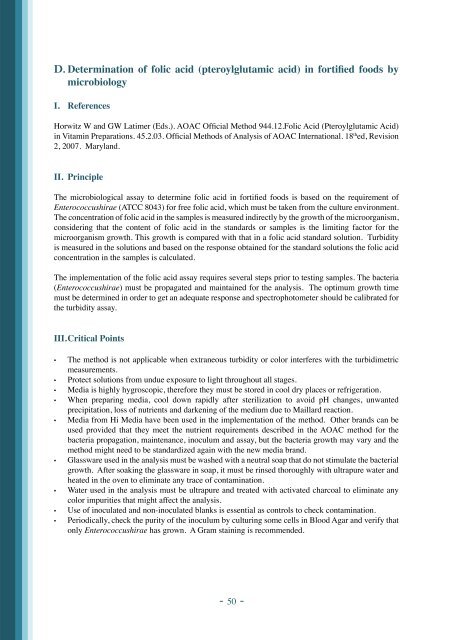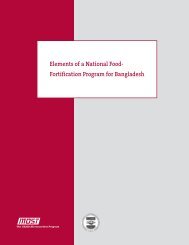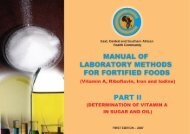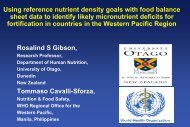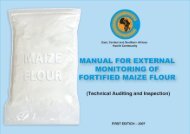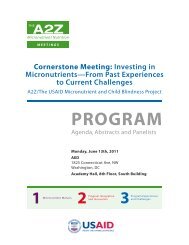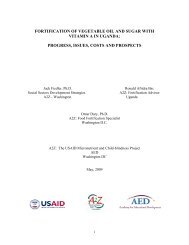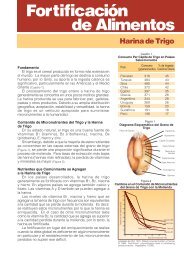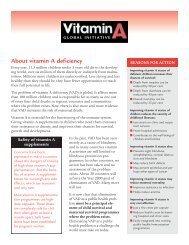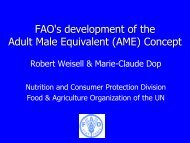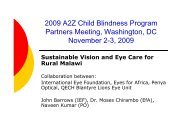manual of methods for determining micronutrients in fortified foods
manual of methods for determining micronutrients in fortified foods
manual of methods for determining micronutrients in fortified foods
You also want an ePaper? Increase the reach of your titles
YUMPU automatically turns print PDFs into web optimized ePapers that Google loves.
D. Determ<strong>in</strong>ation <strong>of</strong> folic acid (pteroylglutamic acid) <strong>in</strong> <strong>for</strong>tified <strong>foods</strong> by<br />
microbiology<br />
I. References<br />
Horwitz W and GW Latimer (Eds.). AOAC Official Method 944.12.Folic Acid (Pteroylglutamic Acid)<br />
<strong>in</strong> Vitam<strong>in</strong> Preparations. 45.2.03. Official Methods <strong>of</strong> Analysis <strong>of</strong> AOAC International. 18 th ed, Revision<br />
2, 2007. Maryland.<br />
II. Pr<strong>in</strong>ciple<br />
The microbiological assay to determ<strong>in</strong>e folic acid <strong>in</strong> <strong>for</strong>tified <strong>foods</strong> is based on the requirement <strong>of</strong><br />
Enterococcushirae (ATCC 8043) <strong>for</strong> free folic acid, which must be taken from the culture environment.<br />
The concentration <strong>of</strong> folic acid <strong>in</strong> the samples is measured <strong>in</strong>directly by the growth <strong>of</strong> the microorganism,<br />
consider<strong>in</strong>g that the content <strong>of</strong> folic acid <strong>in</strong> the standards or samples is the limit<strong>in</strong>g factor <strong>for</strong> the<br />
microorganism growth. This growth is compared with that <strong>in</strong> a folic acid standard solution. Turbidity<br />
is measured <strong>in</strong> the solutions and based on the response obta<strong>in</strong>ed <strong>for</strong> the standard solutions the folic acid<br />
concentration <strong>in</strong> the samples is calculated.<br />
The implementation <strong>of</strong> the folic acid assay requires several steps prior to test<strong>in</strong>g samples. The bacteria<br />
(Enterococcushirae) must be propagated and ma<strong>in</strong>ta<strong>in</strong>ed <strong>for</strong> the analysis. The optimum growth time<br />
must be determ<strong>in</strong>ed <strong>in</strong> order to get an adequate response and spectrophotometer should be calibrated <strong>for</strong><br />
the turbidity assay.<br />
III. Critical Po<strong>in</strong>ts<br />
• The method is not applicable when extraneous turbidity or color <strong>in</strong>terferes with the turbidimetric<br />
measurements.<br />
• Protect solutions from undue exposure to light throughout all stages.<br />
• Media is highly hygroscopic, there<strong>for</strong>e they must be stored <strong>in</strong> cool dry places or refrigeration.<br />
• When prepar<strong>in</strong>g media, cool down rapidly after sterilization to avoid pH changes, unwanted<br />
precipitation, loss <strong>of</strong> nutrients and darken<strong>in</strong>g <strong>of</strong> the medium due to Maillard reaction.<br />
• Media from Hi Media have been used <strong>in</strong> the implementation <strong>of</strong> the method. Other brands can be<br />
used provided that they meet the nutrient requirements described <strong>in</strong> the AOAC method <strong>for</strong> the<br />
bacteria propagation, ma<strong>in</strong>tenance, <strong>in</strong>oculum and assay, but the bacteria growth may vary and the<br />
method might need to be standardized aga<strong>in</strong> with the new media brand.<br />
• Glassware used <strong>in</strong> the analysis must be washed with a neutral soap that do not stimulate the bacterial<br />
growth. After soak<strong>in</strong>g the glassware <strong>in</strong> soap, it must be r<strong>in</strong>sed thoroughly with ultrapure water and<br />
heated <strong>in</strong> the oven to elim<strong>in</strong>ate any trace <strong>of</strong> contam<strong>in</strong>ation.<br />
• Water used <strong>in</strong> the analysis must be ultrapure and treated with activated charcoal to elim<strong>in</strong>ate any<br />
color impurities that might affect the analysis.<br />
• Use <strong>of</strong> <strong>in</strong>oculated and non-<strong>in</strong>oculated blanks is essential as controls to check contam<strong>in</strong>ation.<br />
• Periodically, check the purity <strong>of</strong> the <strong>in</strong>oculum by cultur<strong>in</strong>g some cells <strong>in</strong> Blood Agar and verify that<br />
only Enterococcushirae has grown. A Gram sta<strong>in</strong><strong>in</strong>g is recommended.<br />
- 50 -


